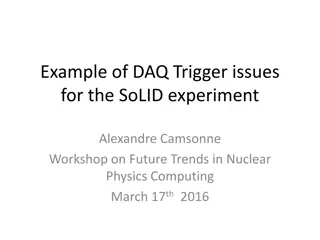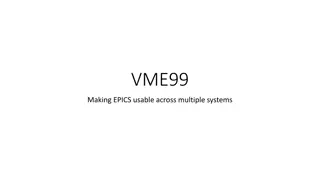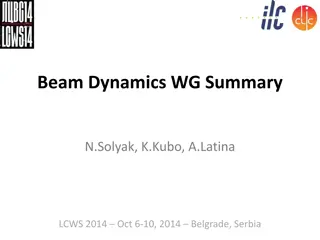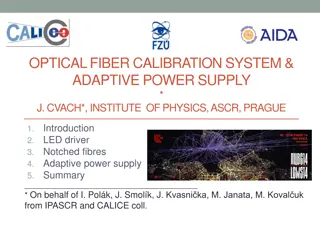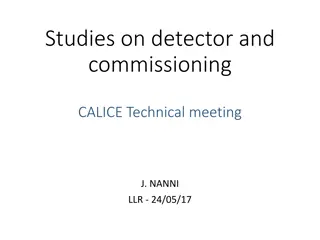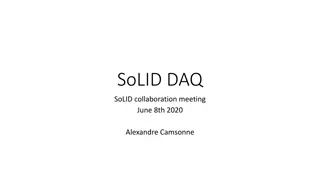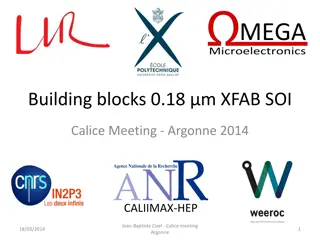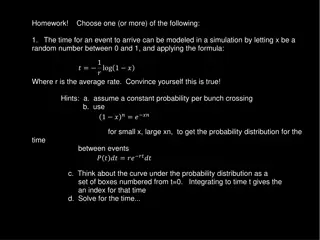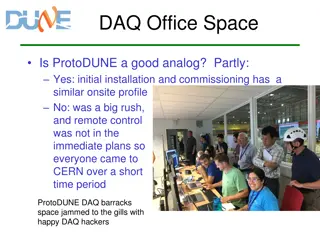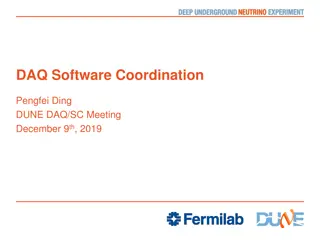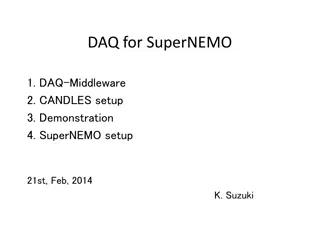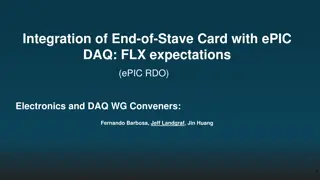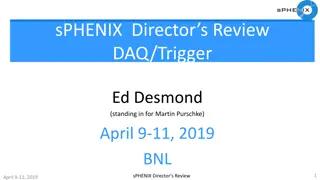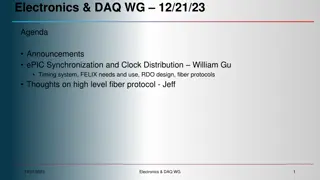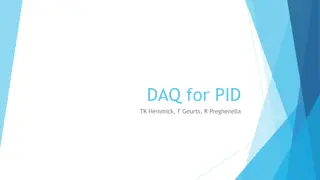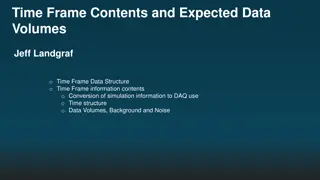
Future Directions for CALICE DAQ Group by David Bailey
Explore the future directions outlined by David Bailey for the CALICE DAQ Group in utilizing off-the-shelf technology, minimizing costs, and leveraging industrial knowledge. The objectives focus on scalability, avoiding prescriptive design, and utilizing commodity hardware. The architecture involves classic design concepts, front-end systems, data concentrators, and network switching for efficient data processing and storage.
Download Presentation

Please find below an Image/Link to download the presentation.
The content on the website is provided AS IS for your information and personal use only. It may not be sold, licensed, or shared on other websites without obtaining consent from the author. If you encounter any issues during the download, it is possible that the publisher has removed the file from their server.
You are allowed to download the files provided on this website for personal or commercial use, subject to the condition that they are used lawfully. All files are the property of their respective owners.
The content on the website is provided AS IS for your information and personal use only. It may not be sold, licensed, or shared on other websites without obtaining consent from the author.
E N D
Presentation Transcript
Future DAQ Directions David Bailey for the CALICE DAQ Group
Objectives Not to be prescriptive at present... Utilise as much off the shelf technology as possible Minimise cost, leverage industrial knowledge Standard networking chipsets and protocols, FPGAs etc. Not tied in to a particular design based on specific hardware Scalable From single, low-bandwidth systems to high-rate environments As generic as possible Clearly there will need to be sub-detector specific hardware at the (very) front-end but try to be homogenous downstream ... but attempting to act as a catalyst to use commodity hardware instead of following the usual bespoke route. 2 David Bailey 31st May 2007
Overview Classic Design Front-ends read out into on- detector data concentrators Data concentrators drive long links off detector Off detector assembly of complete bunch train data and event storage Points to note Triggerless operation Use inter-bunch-train gaps to send data off detector Bunch train data processed/assembled near online asynchronously from readout Front End Data Concentrators Network switching, processing and storage 3 David Bailey 31st May 2007
Current Architecture Front End (FE) Have to understand data transport on long (1.7m) PCBs Very Front End (VFE) Conf/ Clock Clock+Config+Cont rol VFE ASIC FE FPGA VFE ASIC VFE ASIC VFE ASIC PHY Simulated ECAL slab with prototype DIF Slab RamFul Data l FPGA Config/Clock Extract Clk Clock BOOT CONFIG FE-FPGA Data Format Zero Suppress Protocol/SerDes Bunch/Train Timing Config Data VFE ASIC 1G/100Mb Ethernet PHY Data ADC Schematic layout of VFE for ECAL. Front End FPGA on DIF board provides control and data paths for detector ASICS 4 David Bailey 31st May 2007
Current Architecture ASICs ASICs ASICs DIF Sub-detector specific component (Detector InterFace) Supplied with low jitter clock from first-stage concentrator (LDA) 50MHz with ns jitter All detector-specific clocks are derived from input master clock on the DIF Bi-directional serial links to LDA Would like these to be generic driven by highest bandwidth requirement Require fixed latency links if clock and control encoded across them Clock feed through and redundant data links to neighbouring DIF for readout and clock redundancy Standard firmware to talk to DAQ DIF DIF DIF FE LDA Clock / Fast Control CCC-link Data-link ODR ODR Machine Clock Store PC 5 David Bailey 31st May 2007
Current Architecture DIF LDA Interface Keep it simple Standard 10/16 pin IDC format connector Power from DIF for potential link serdes (3V3 and 2V5 at 250mA) Input from/to LDA Serial In Serial Out Clock In (may be recovered from link) All LVDS 2V5 8B10B encoding (or Manchester) 2V5 3V3 In + Out + Clk + 0V 0V In - Out - Clk - 6 David Bailey 31st May 2007
Current Architecture DIF DIF Same format as LDA interface Used for redundant communications and clock between DIFs in case primary link fails Or allows DIF to act as Interface to downstream DAQ for many channels from VFE Require 2 extra single ended lines to specify link and clock direction Master/Slave signal to define clock master CMOS 2V5 suggested Maybe use a single 3-state line later 2V5 3V3 In + Out + Clk + Out In 0V 0V In - Out - Clk - 7 David Bailey 31st May 2007
Current Architecture LDA On (or very near)-detector data concentrator Clock/control fan-out Data receive and buffering from DIFs Framing/error correction for transmission off detector Possible direct connection to machine timing Fixed latency links to DIF Downstream links need not be fixed latency Obviously makes sense to try to have upstream and downstream LDA-Off Detector from the same technology May be able to use commercial Ethernet chipsets ASICs ASICs ASICs DIF DIF DIF FE LDA Clock / Fast Control CCC-link Data-link ODR ODR Machine Clock Store PC 8 David Bailey 31st May 2007
Current Architecture ASICs ASICs ASICs ODR Off-Detector Receiver Gets data into a usable form for processing Three logical tasks Receive Process Store Current implementation using Virtex 4 FPGA development boards connected over PCI- express in a PC Input is Ethernet for testing DIF DIF DIF FE LDA Clock / Fast Control CCC-link Data-link ODR ODR Machine Clock Store PC 9 David Bailey 31st May 2007
Prototype ODR Development board from PLDApplications 8 lane PCI-e card Xilinx Virtex4FX60 FPGA DDR2 memory 2 SFP cages 1GigE 2 HSSDC connectors Can drive/receive 1Gbit Ethernet direct to FPGA on the board 10Gbit possible with addition of small daughter card Will also be able to test some LDA functionality using on- board LVDS outputs Demonstrated 1Gbit Ethernet operation from this board - See proceedings of IEEE NPSS Real Time Conference 2007 for details 10 David Bailey 31st May 2007
Prototype ODR Prototype is working Firmware done Host PC driver working Rate tests underway Achieving reasonable throughput to disk on this first iteration Bottom line: The ODR prototype works! Data size 4000 bytes 45000 40000 35000 Transfer rate [kB/s] 30000 25000 DMA3 1 RQ DMA3 2 RQ 20000 15000 10000 5000 0 0 10 20 30 Number of IO threads 11 David Bailey 31st May 2007
Next steps Make an LDA Will certainly use something that exists already Spartan 3 development board or something similar Investigate LDA DIF links How much bandwidth do we really need? Should we try something off the shelf like GLINK? Have to define ODR LDA link Does it need to be synchronous for clock & control? i.e. Where does C&C enter the system? LDA or further downstream? Can we use commercial Ethernet chipsets? Have to have an answer in about a year... 12 David Bailey 31st May 2007

